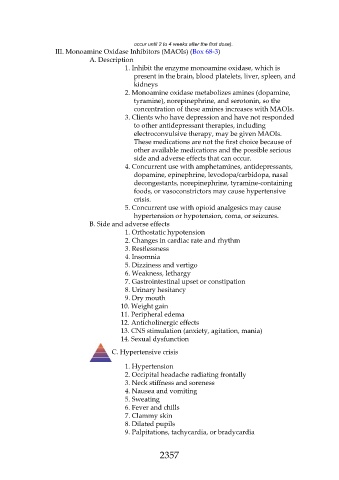Page 2357 - Saunders Comprehensive Review For NCLEX-RN
P. 2357
occur until 2 to 4 weeks after the first dose).
III. Monoamine Oxidase Inhibitors (MAOIs) (Box 68-3)
A. Description
1. Inhibit the enzyme monoamine oxidase, which is
present in the brain, blood platelets, liver, spleen, and
kidneys
2. Monoamine oxidase metabolizes amines (dopamine,
tyramine), norepinephrine, and serotonin, so the
concentration of these amines increases with MAOIs.
3. Clients who have depression and have not responded
to other antidepressant therapies, including
electroconvulsive therapy, may be given MAOIs.
These medications are not the first choice because of
other available medications and the possible serious
side and adverse effects that can occur.
4. Concurrent use with amphetamines, antidepressants,
dopamine, epinephrine, levodopa/carbidopa, nasal
decongestants, norepinephrine, tyramine-containing
foods, or vasoconstrictors may cause hypertensive
crisis.
5. Concurrent use with opioid analgesics may cause
hypertension or hypotension, coma, or seizures.
B. Side and adverse effects
1. Orthostatic hypotension
2. Changes in cardiac rate and rhythm
3. Restlessness
4. Insomnia
5. Dizziness and vertigo
6. Weakness, lethargy
7. Gastrointestinal upset or constipation
8. Urinary hesitancy
9. Dry mouth
10. Weight gain
11. Peripheral edema
12. Anticholinergic effects
13. CNS stimulation (anxiety, agitation, mania)
14. Sexual dysfunction
C. Hypertensive crisis
1. Hypertension
2. Occipital headache radiating frontally
3. Neck stiffness and soreness
4. Nausea and vomiting
5. Sweating
6. Fever and chills
7. Clammy skin
8. Dilated pupils
9. Palpitations, tachycardia, or bradycardia
2357

